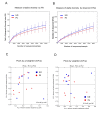A common microbial signature is present in the lower airways of interstitial lung diseases including sarcoidosis
- PMID: 32476923
- PMCID: PMC7170129
- DOI: 10.36141/svdld.v35i4.7061
A common microbial signature is present in the lower airways of interstitial lung diseases including sarcoidosis
Abstract
Background: The etiology of pulmonary sarcoidosis is not well established. Although the mechanism triggering pulmonary sarcoidosis remains to be established, inflammatory reactions seem to play an important role in this process. Objectives: The aim of this study was to define the composition of the lower airway microbiota in the bronchoalveolar lavage (BAL) of patients affected by interstitial lung diseases, including sarcoidosis, to determine whether the bacterial signature differs among these diseases. Methods: Ten patients affected by pulmonary sarcoidosis and 9 patients affected by other interstitial lung diseases were enrolled. 16S rRNA next-generation sequencing was used to study BAL microbial composition of these patients, and were also compared with already published microbial content in higher airways of such diseases. Results: Four phyla dominated the lower airway microbiota, Bacteroidetes being the most abundant phylum in both groups (56.9%). Diversity analysis showed no significant differences between the various diseases, particularly between pulmonary sarcoidosis and other interstitial lung diseases affecting lower airways. Conclusions: Our data indicate that the bacterial lower airways microbiota share the same signature and, therefore, cannot be used as a diagnostic tool to discriminate among different interstitial lung diseases, including sarcoidosis, while microbial diversity is present when considering lower or higher respiratory airways. (Sarcoidosis Vasc Diffuse Lung Dis 2018; 35: 354-362).
Keywords: airway microbiota; bronchoalveolar lavage (BAL); interstitial lung diseases; next generation sequencing; pulmonary sarcoidosis.
Copyright: © 2018 SARCOIDOSIS VASCULITIS AND DIFFUSE LUNG DISEASES.
Figures




Similar articles
-
Microbial communities in the respiratory tract of patients with interstitial lung disease.Thorax. 2013 Dec;68(12):1150-6. doi: 10.1136/thoraxjnl-2012-202917. Epub 2013 Aug 14. Thorax. 2013. PMID: 23945167 Free PMC article.
-
Bronchoalveolar Lavage Fluid Characteristics of Patients With Sarcoidosis and Nonsarcoidosis Interstitial Lung Diseases: Ten-Year Experience of a Single Center in Turkey.Iran Red Crescent Med J. 2015 Oct 28;17(10):e31103. doi: 10.5812/ircmj.31103. eCollection 2015 Oct. Iran Red Crescent Med J. 2015. PMID: 26566455 Free PMC article.
-
Comparative analysis of the alveolar microbiome in COPD, ECOPD, Sarcoidosis, and ILD patients to identify respiratory illnesses specific microbial signatures.Sci Rep. 2021 Feb 17;11(1):3963. doi: 10.1038/s41598-021-83524-2. Sci Rep. 2021. PMID: 33597669 Free PMC article.
-
Sarcoidosis of the upper and lower airways.Expert Rev Respir Med. 2011 Dec;5(6):823-33. doi: 10.1586/ers.11.66. Expert Rev Respir Med. 2011. PMID: 22082167 Review.
-
The role of bronchoalveolar lavage in diffuse parenchymal lung diseases.Curr Opin Pulm Med. 2005 Sep;11(5):417-21. doi: 10.1097/01.mcp.0000175522.49353.e1. Curr Opin Pulm Med. 2005. PMID: 16093816 Review.
Cited by
-
Microbiome Against the Background of the Complex Aetiology in Sarcoidosis-What Do We Already Know?Life (Basel). 2025 Jul 4;15(7):1069. doi: 10.3390/life15071069. Life (Basel). 2025. PMID: 40724571 Free PMC article. Review.
-
Molecular profiling in sarcoidosis.Curr Opin Pulm Med. 2020 Sep;26(5):562-567. doi: 10.1097/MCP.0000000000000716. Curr Opin Pulm Med. 2020. PMID: 32701678 Free PMC article. Review.
-
The lower airways microbiota and antimicrobial peptides indicate dysbiosis in sarcoidosis.Microbiome. 2022 Oct 19;10(1):175. doi: 10.1186/s40168-022-01362-4. Microbiome. 2022. PMID: 36258251 Free PMC article.
-
Microbiota, probiotics and respiratory infections: the three musketeers can tip off potential management of COVID-19.Am J Transl Res. 2021 Oct 15;13(10):10977-10993. eCollection 2021. Am J Transl Res. 2021. PMID: 34786037 Free PMC article. Review.
-
Microbiome Influence in the Pathogenesis of Prion and Alzheimer's Diseases.Int J Mol Sci. 2019 Sep 23;20(19):4704. doi: 10.3390/ijms20194704. Int J Mol Sci. 2019. PMID: 31547531 Free PMC article. Review.
References
-
- Chen ES, Moller DR. Sarcoidosis--scientific progress and clinical challenges. Nat Rev Rheumatol. 2011 Jul 12;7(8):457–67. - PubMed
-
- Iannuzzi MC, Rybicki BA, Teirstein AS. Sarcoidosis. N Engl J Med. 2007 Nov 22;357(21):2153–65. - PubMed
-
- Medica I, Kastrin A, Maver A, Peterlin B. Role of genetic polymorphisms in ACE and TNF-alpha gene in sarcoidosis: a meta-analysis. J Hum Genet. 2007;52(10):836–847. - PubMed
-
- Müller-Quernheim J, Schürmann M, Hofmann S, Gaede KI, Fischer A, Prasse A, et al. Genetics of sarcoidosis. Clin Chest Med. 2008 Sep;29(3):391–414. - PubMed
-
- Sverrild A, Backer V, Kyvik KO, Kaprio J, Milman N, Svendsen CB, et al. Heredity in sarcoidosis: a registry-based twin study. Thorax. 2008 Oct;63(10):894–6. - PubMed
LinkOut - more resources
Full Text Sources
